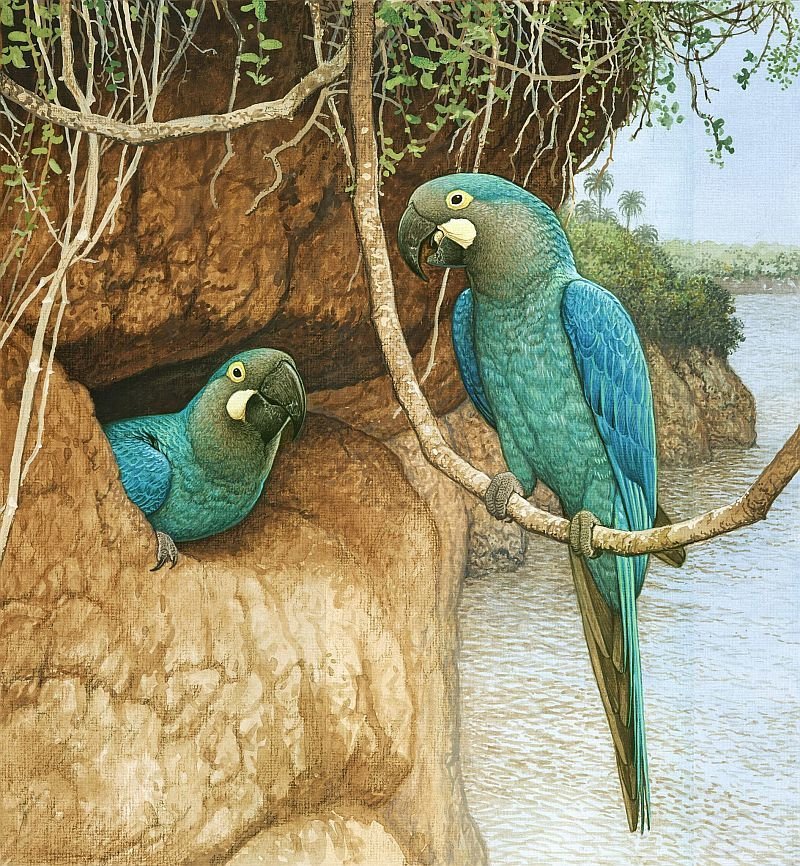Glaucous Macaw species was final recorded within the 1960s and it’s liable to have declined extraordinarily consequently of catching and buying and selling, along with pure surrounding of risk, debasement and decimation. Nonetheless, Glaucous Macaw it’d effectively keep surviving, on the grounds that not the vast majority of its a while in the past substantial attain has been satisfactorily studied, and there have been tenacious and persuading close by stories. Any remaining populace is liable to be small, and thus it’s handled as Critically Endangered.
Facts, Life-span, Size

70 cm (27.5 in) lengthy, for probably the most half pale turquoise-blue with an expansive grayish head. It has a protracted tail and a considerable invoice. It has a yellow, uncovered eye-ring and half-moon-formed lappets circumscribing the mandible. Glaucous macaw life cycle isn’t recorded effectively, some say they lived 14 – 20 years, however as most bigger parrots simply stay 60+ years, there’s no cause that this Glaucous Macaw couldn’t stay as lengthy.
Glaucous Macaw Conservation Status:
IUCN/CITES Standing: Critically Endangered (Probably Extinct) / Appendix I
Wild inhabitants: Seemingly none
The place discovered: Previously confined to areas in center reaches of Rio Paraguay, Rio Parana and Rio Uruguay, in SE Paraguay, NE Argentina, in Corrientes and presumably Misiones, and Rio Grande do Sul, SE Brazil; presumably additionally Artigas, NW Uruguay.
Historical past: Anodorhynchus glaucus was previously widespread in N Argentina, S Paraguay, NE Uruguay and Brazil from Paraná state southwards. It was native to the areas across the main rivers (Uruguay, Paraná and Paraguay), with most data coming from Corrientes, Argentina. It was already uncommon within the second half of the 19th century, with solely two acceptable sightings within the 20th century, together with one direct commentary in Uruguay in 1951 and one primarily based on native stories. This species has been typically handled as extinct, nevertheless a number of locals have reported sightings lately.
Threats:
This species’ inhabitants doubtless declined quickly because of human settlement of the foremost river basins inside its vary. It was presumably hunted and brought for the chook commerce as a result of it was conspicuous, each in measurement and color. There may be some proof that it was trapped, however little to assist varied claims that there was latest commerce.
Ecology: The Glaucous Macaw was initially present in Paraguay, Argentina and Brazil. It was seen in subtropical gallery forests with cliffs and flippantly wooded palm-rich savannas, the place it could feed on the nuts of Butia yatay palms. It was a chook that was doubtless gregarious, nesting in steep banks or cliffs, or much less usually, tree cavities.
Conceivable causes for his or her decay/conceivable termination
The elemental objective behind their decay is accepted to be the far reaching lack of palm-forests, both via direct freedom for agribusiness or the concealment of restoration by nibbling cows.
Nonetheless, cheap residing area nonetheless stays in El Palmar Nationwide Park within the Argentine space of Entre Ríos, the place some may have survived and, no doubt, persevering bits of gossip about their presence nonetheless exist.
Different conceivable or contributing parts for the decay of their numbers in nineteenth century are accepted to be the accompanying:
- Settlement of the true waterway bowls inside its attain
- In the middle of the latest century, their residing area skilled radical modifications due to space restoration.
- Chasing for his or her quills and tissue for nourishment
- Catching for various causes, (for instance, exchanging eggs, skins or stay examples)
- Conceivable sickness flare-up
- Predation
- Risks was apparently joined by the boundless lack of palm-forests,




